Comparative Study on the Kinetics of the Isothermal Reduction of Iron Ore Composite Pellets Using Coke, Charcoal, and Biomass as Reducing Agents
Abstract
1. Introduction
2. Materials and Methods
2.1. Materials
2.2. Experimental Procedure
3. Results and Discussion
3.1. Reduction Mechanism Analysis
3.2. Comparison of the Reduction Behaviors of Carbon Iron Ore Composite Pellets with Different Reducing Agents
3.3. Kinetic Analysis
3.4. Evaluation of the Apparent Activation Energies of Composite Pellets with Different Reducing Agents
4. Conclusions
Author Contributions
Funding
Data Availability Statement
Conflicts of Interest
References
- Zandi, M.; Martinez-Pacheco, M.; Fray, T.A.T. Biomass for iron ore sintering. Miner. Eng. 2010, 23, 1139–1145. [Google Scholar] [CrossRef]
- Suopajarvi, H.; Pongracz, E.; Fabritius, T. The potential of using biomass-based reducing agents in the blast furnace: A review of thermochemical conversion technologies and assessments related to sustainability. Renew. Sus. Energy Rev. 2013, 25, 511–528. [Google Scholar] [CrossRef]
- Valeev, D.; Zinoveev, D.; Kondratiev, A.; Lubyanoi, D.; Pankratov, D. Reductive smelting of neutralized red mud for iron recovery and produced pig iron for heat-resistant castings. Metals 2020, 10, 32. [Google Scholar] [CrossRef]
- Castro, J.A.D.; Medeiros, G.A.D.; Oliveira, E.M.D.; Campos, M.F.D.; Nogami, H. The mini blast furnace process: An efficient reactor for green pig iron production using Charcoal and Hydrogen-Rich Gas: A Study of Cases. Metals 2020, 10, 1501. [Google Scholar] [CrossRef]
- Sohn, H.Y. Energy Consumption and CO2 emissions in ironmaking and development of a novel flash technology. Metals 2020, 10, 54. [Google Scholar] [CrossRef]
- Li, S.; Pan, J.; Zhu, D.; Guo, Z.; Shi, Y.; Chou, J.; Wu, J. An innovative technique for comprehensive utilization of high aluminum iron ore via pre-reduced-smelting separation-alkaline leaching process: Part I: Pre-reduced-smelting separation to recover iron. Metals 2020, 10, 57. [Google Scholar] [CrossRef]
- Strezov, V. Iron ore reduction using sawdust: Experimental analysis and kinetic modelling. Renew. Energy 2006, 31, 1892–1905. [Google Scholar] [CrossRef]
- Gan, M.; Fan, X.; Ji, Z.; Jiang, T.; Chen, X.; Yu, Z.; Li, G.; Yin, L. Application of biomass fuel in iron ore sintering: Influencing mechanism and emission reduction. Ironmak. Steelmak. 2015, 42, 27–33. [Google Scholar] [CrossRef]
- Castro, J.A.; Medeiros, G.A.; Oliveira, E.M.; Silva, L.M.; Nogami, H. A comprehensive modeling as a tool for developing new mini blast furnace technologies based on biomass and hydrogen operation. Sustain. Metall. 2020, 6, 281–293. [Google Scholar] [CrossRef]
- Rejdak, M.; Robak, J.; Czardybon, A.; Karina, L.; Fudała, P. Research on the production of composite fuel on the basis of fine-grained coal fractions and biomass—The impact of process parameters and the type of binder on the quality of briquettes produced. Minerals 2020, 10, 31. [Google Scholar] [CrossRef]
- El-Tawil, A.A.; Ökvist, L.S.M.; Ahmed, H.; Björkman, B. Devolatilization kinetics of different types of bio-coals using thermogravimetric analysis. Metals 2019, 9, 168. [Google Scholar] [CrossRef]
- Fruehan, R.J. Rate of reduction of iron oxides by carbon. Metall. Mater. Trans. B 1977, 8, 279–286. [Google Scholar] [CrossRef]
- Wang, Q.; Yang, Z.; Tian, J.; Li, W.; Sun, J. Mechanisms of reduction in iron ore-coal composite pellets. Ironmak. Steelmak. 1997, 24, 457–460. [Google Scholar]
- Liu, G.S.; Strezov, V.; Lucas, J.A.; Wibberley, L.J. Thermal investigations of direct iron ore reduction with coal. Thermochim. Acta 2004, 410, 133–140. [Google Scholar] [CrossRef]
- Strezov, V.; Liu, G.S.; Lucas, J.A.; Wibberley, L.J. Computational calorimetric study of the iron ore reduction reactions in mixtures with coal. Ind. Eng. Chem. Res. 2005, 44, 621–626. [Google Scholar] [CrossRef]
- Mousa, E.; Lundgren, M.; Ökvist, L.S.; From, L.E.; Robles, A.; Hällsten, S.; Sundelin, B.; Friberg, H.; El-Tawil, A. Reduced carbon consumption and CO2 emission at the blast furnace by use of briquettes containing torrefied sawdust. J. Sustain. Metall. 2019, 5, 391–401. [Google Scholar] [CrossRef]
- Ding, Y.G.; Wang, J.S.; She, X.F.; Wang, G.; Xue, Q.G. Reduction Characteristics and Kinetics of Bayanobo Complex Iron Ore Carbon Bearing Pellets. J. Iron Steel Res. Int. 2013, 20, 28–33. [Google Scholar] [CrossRef]
- Shi, J.Y.; Donskoi, E.; Mcelwain, D.L.S.; Wibberley, L.J. Modelling the reduction of an iron ore-coal composite pellet with conduction and convection in an axisymmetric temperature field. Math. Comput. Model. 2005, 42, 45–60. [Google Scholar] [CrossRef]
- Mae, K.; Inaba, A.; Hanaki, K.; Okuma, O. Production of iron/carbon composite from low rank coal as a recycle material for steel industry. Fuel 2005, 84, 227–233. [Google Scholar] [CrossRef]
- Pandey, B.K.; Sharma, T. Reducing agents and double-layered iron ore pellets. Int. J. Miner. Process. 2000, 59, 295–304. [Google Scholar] [CrossRef]
- Chowdhury, G.M.; Roy, G.G.; Roy, S.K. Reduction kinetics of iron ore-graphite composite pellets in a packed-bed reactor under inert and reactive atmospheres. Metall. Mater. Trans. B 2008, 39, 160–178. [Google Scholar] [CrossRef]
- Ueda, S.; Watanabe, K.; Yanagiya, K.; Inoue, R.; Ariyama, T. Improvement of reactivity of carbon iron ore composite with biomass char for blast furnac. ISIJ Int. 2009, 49, 1505–1512. [Google Scholar] [CrossRef]
- Fu, J.X.; Zhang, C.; Hwang, W.S.; Liau, Y.T.; Lin, Y.T. Exploration of biomass char for CO2 reduction in RHF process for steel production. Int. J. Green Gas Con. 2012, 8, 143–149. [Google Scholar] [CrossRef]
- Wu, Y.; Fang, M.; Lan, L.D.; Zhang, P.; Rao, K.V.; Bao, Z.Y. Rapid and direct magnetization of goethite ore roasted by biomass fuel. Sep. Purif. Technol. 2012, 94, 34–38. [Google Scholar] [CrossRef]
- El-Tawil, A.A.; Ahmed, H.M.; Ökvist, L.S.; Björkman, B. Self-reduction behavior of bio-coal containing iron ore composites. Metals 2020, 10, 133. [Google Scholar] [CrossRef]
- Tang, H.; Yun, Z.; Fu, X.; Du, S. Modeling and experimental study of ore-carbon briquette reduction under CO–CO2 atmosphere. Metals 2018, 8, 205. [Google Scholar] [CrossRef]
- Tang, H.; Sun, Y.; Rong, T. Experimental and numerical investigation of reaction behavior of carbon composite briquette in blast furnace. Metals 2020, 10, 49. [Google Scholar] [CrossRef]
- Habashi, F. Principles of Extractive Metallurgy, General Principles; Gordon and Breach: New York, NY, USA, 1969; pp. 153–163. [Google Scholar]
- Guo, X.Z.; Zhang, B.H.; Yang, H.B. A kinetic of the reduction of ZnO pellets containing graphite. J. Chongqing Univ. (Nat. Sci. Ed.) 2002, 25, 86–88. (In Chinese) [Google Scholar]
- Ding, L. Kinetics and mechanism of reduction of carbon–chromite composite pellets. Ironmak. Steelmak. 1997, 24, 224–229. [Google Scholar]
- Galwey, A.K.; Brown, M.E. Application of the Arrhenius equation to solid state kinetics: Can this be justified. Thermochim. Acta 2002, 386, 91–98. [Google Scholar] [CrossRef]
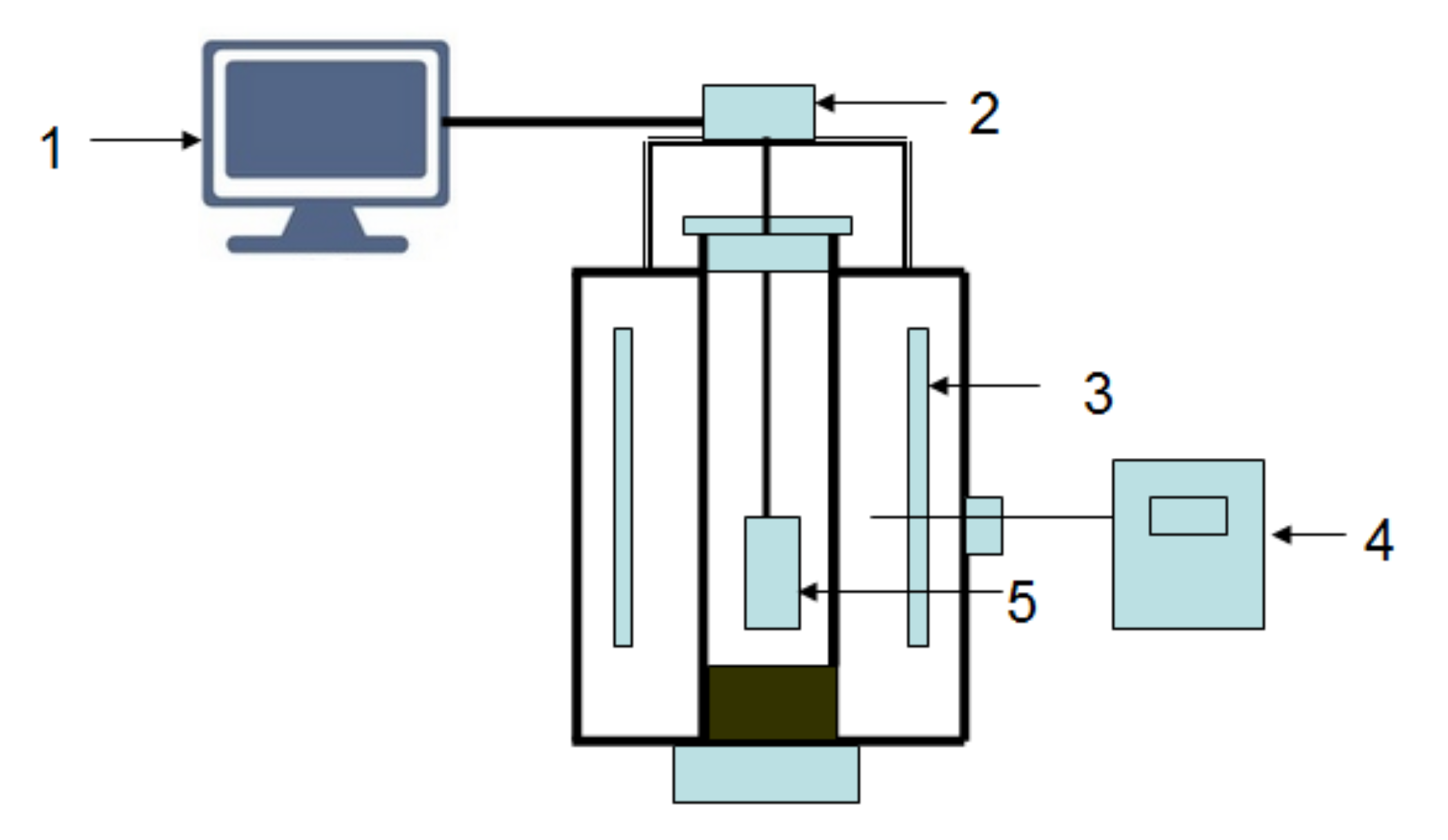
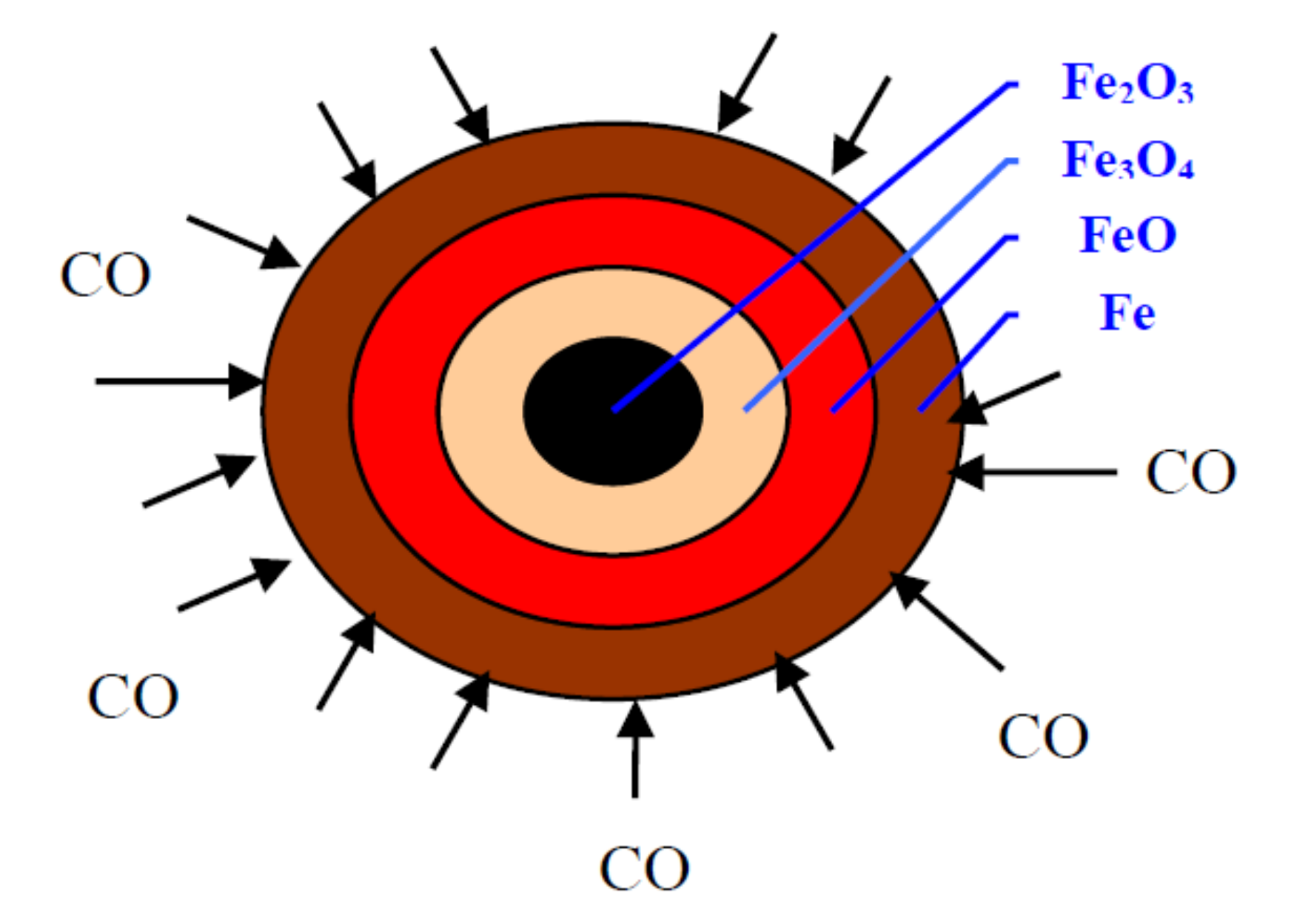

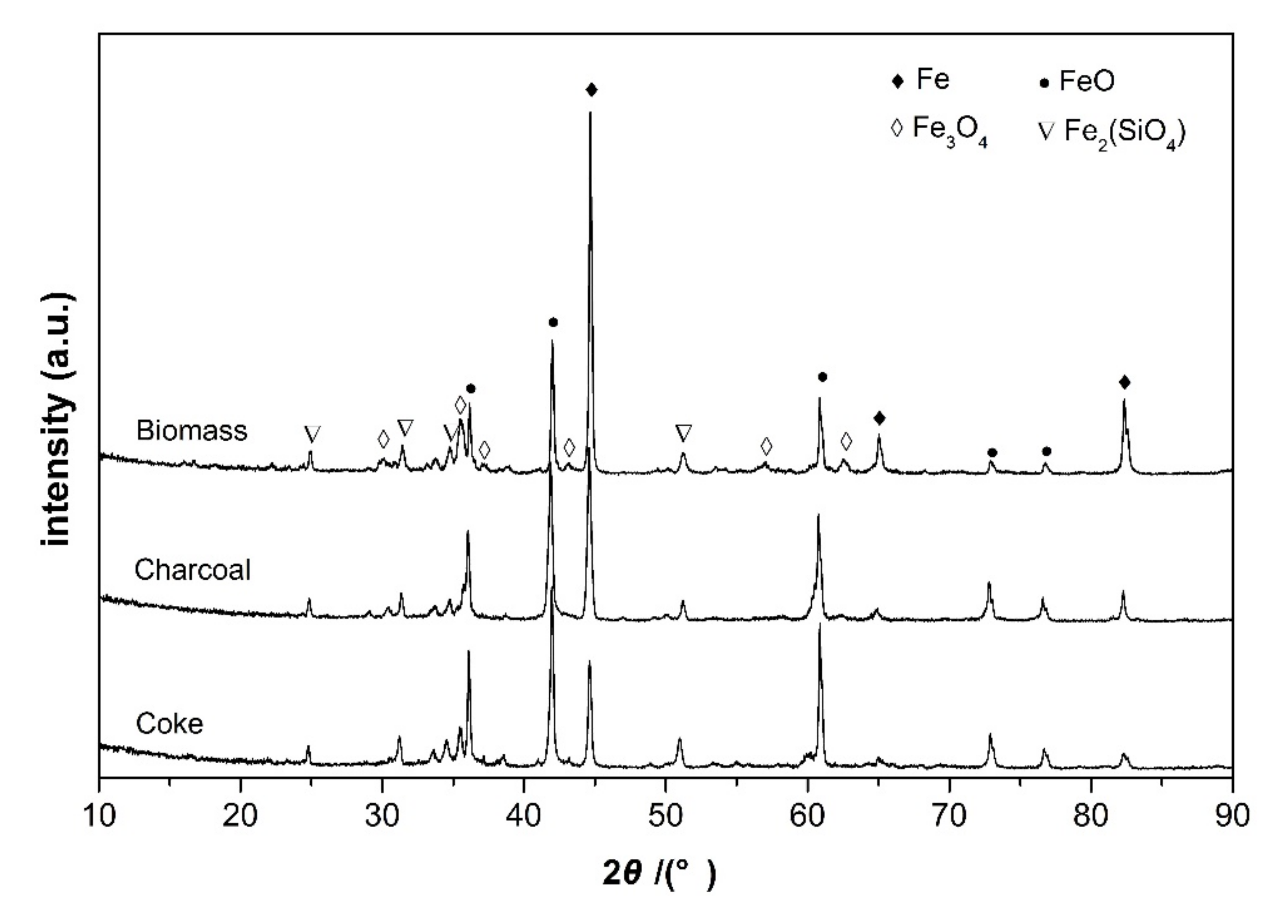

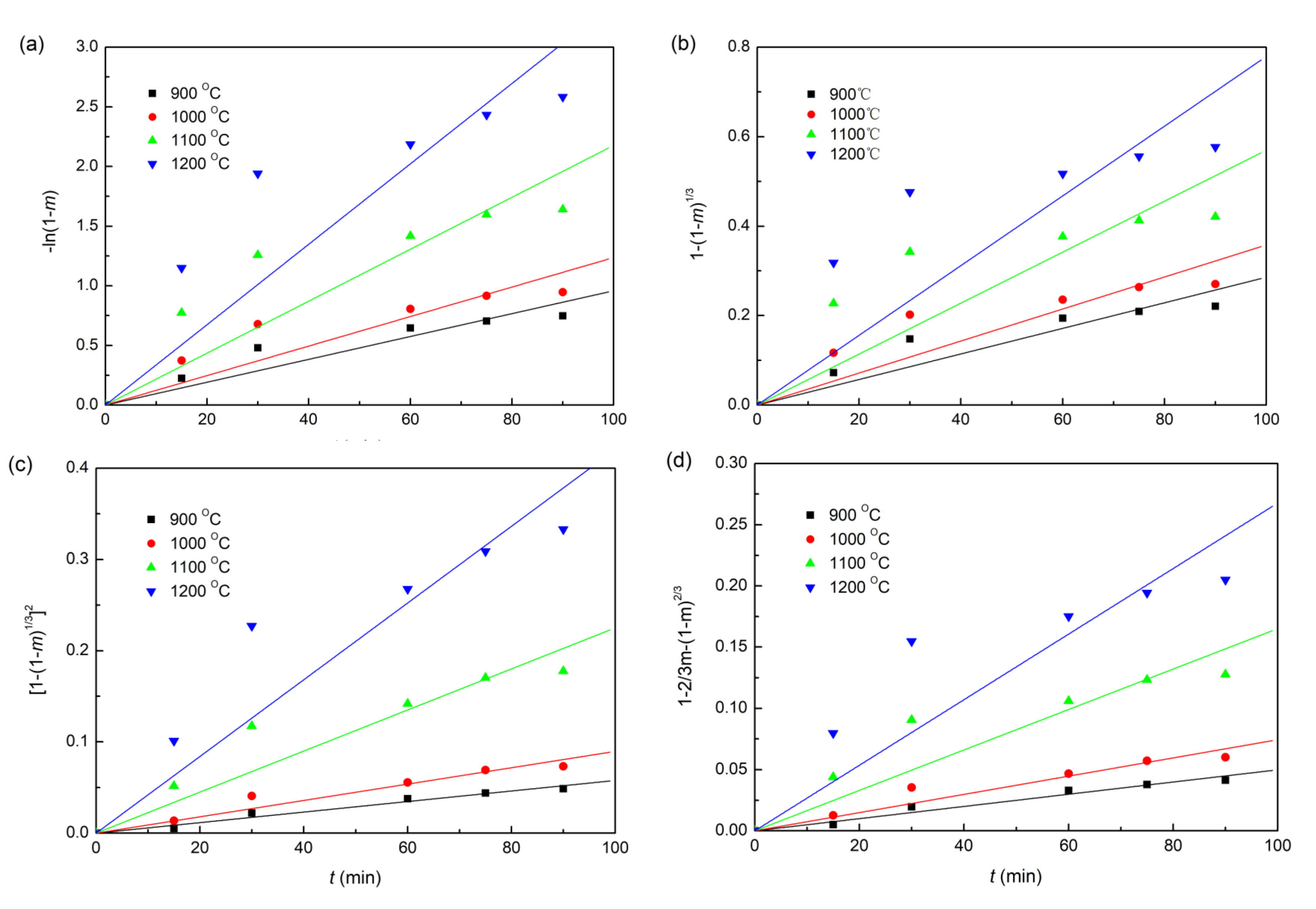
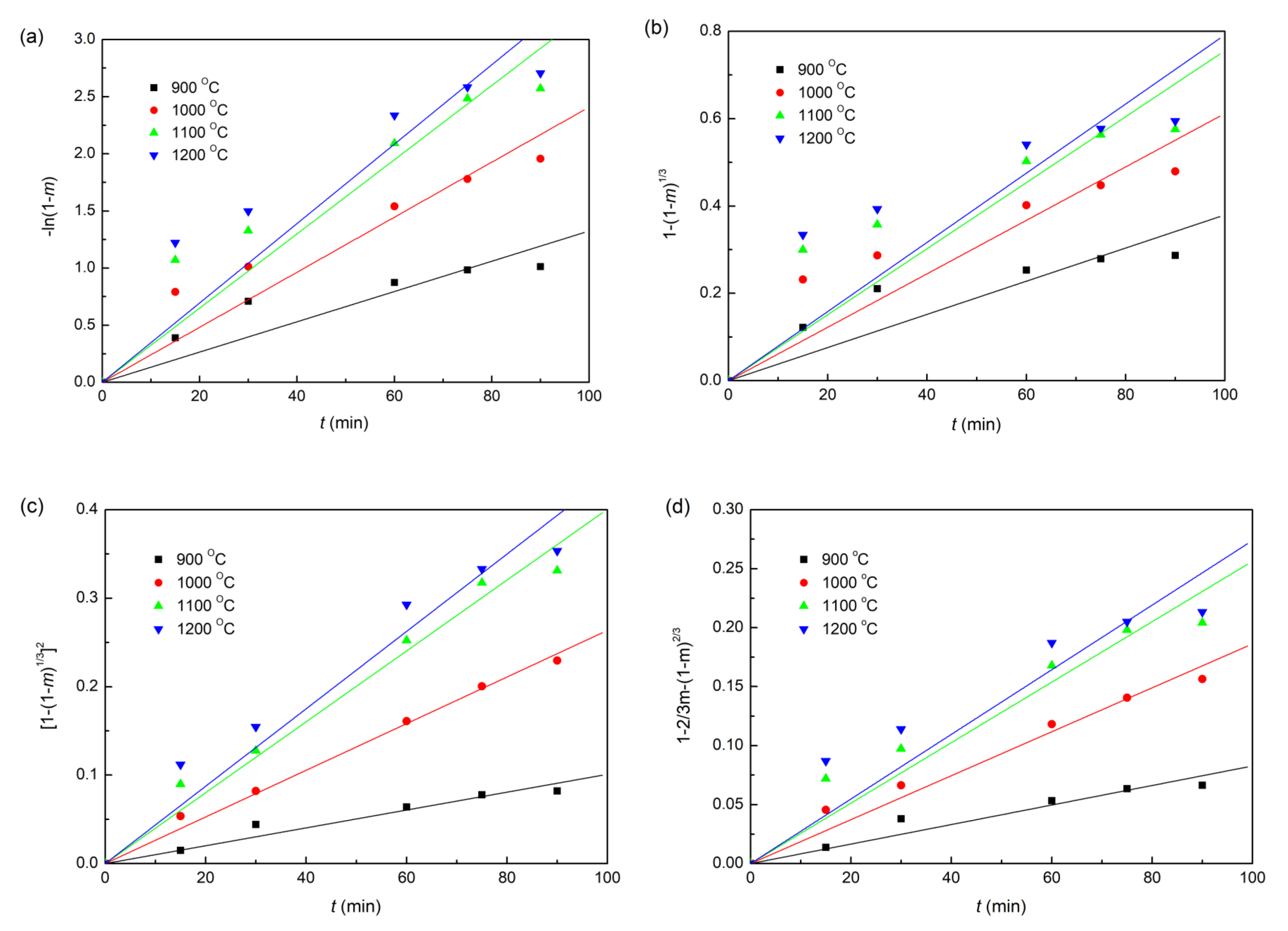

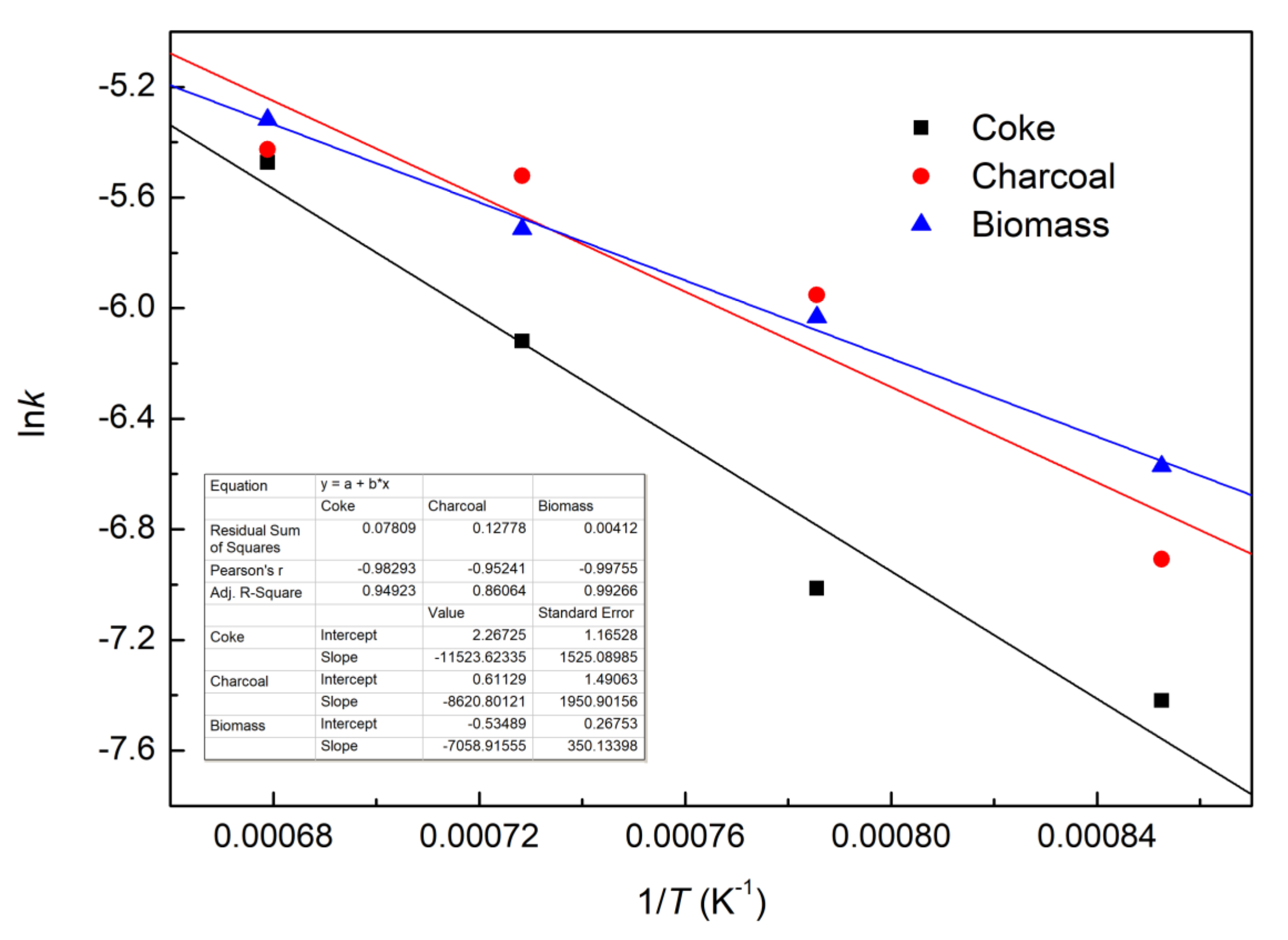
| Raw Materials | TFe | FeO | SiO2 | CaO | MgO | Al2O3 | K2O | Na2O | S | P | LOI |
|---|---|---|---|---|---|---|---|---|---|---|---|
| Iron ore | 65.250 | 1.050 | 3.570 | 0.040 | 0.030 | 1.160 | 0.200 | 0.100 | 0.200 | 0.042 | 1.420 |
| Bentonite | 1.42 | - | 62.56 | 3.060 | 2.980 | 13.16 | 1.660 | 2.190 | 0.010 | 0.015 | - |
| Reducing Agent Name | Moisture | Ash | Volatile Matter | Fixed Carbon |
|---|---|---|---|---|
| Coke | 2.4 | 19.95 | 1.1 | 76.55 |
| Charcoal | - | 2.15 | 15.52 | 82.33 |
| Biomass | - | 3.01 | 11.36 | 85.63 |
| Kinetic Equation | Reducing Agents | 900 °C | 1000 °C | 1100 °C | 1200 °C |
|---|---|---|---|---|---|
| Coke | y = 0.0096x | y = 0.0124x | y = 0.0218x | y = 0.0337x | |
| r2 = 0.957 | r2 = 0.935 | r2 = 0.913 | r2 = 0.919 | ||
| Charcoal | y = 0.0132x | y = 0.0241x | y = 0.0325x | y = 0.0347x | |
| r2 = 0.939 | r2 = 0.965 | r2 = 0.964 | r2 = 0.951 | ||
| Biomass | y = 0.0159x | y = 0.0227x | y = 0.0284x | y = 0.0381x | |
| r2 = 0.934 | r2 = 0.919 | r2 = 0.916 | r2 = 0.918 | ||
| Coke | y = 0.0029x | y = 0.0036x | y = 0.0057x | y = 0.0078x | |
| r2 = 0.950 | r2 = 0.924 | r2 = 0.892 | r2 = 0.885 | ||
| Charcoal | y = 0.0038x | y = 0.0061x | y = 0.0076x | y = 0.0079x | |
| r2 = 0.927 | r2 = 0.940 | r2 = 0.930 | r2 = 0.914 | ||
| Biomass | y = 0.0044x | y = 0.0059x | y = 0.0069x | y = 0.0084x | |
| r2 = 0.918 | r2 = 0.896 | r2 = 0.888 | r2 = 0.877 | ||
| Coke | y = 0.0006x | y = 0.0009x | y = 0.0022x | y = 0.0042x | |
| r2 = 0.990 | r2 = 0.980 | r2 = 0.957 | r2 = 0.951 | ||
| Charcoal | y = 0.0010x | y = 0.0026x | y = 0.0040x | y = 0.0044x | |
| r2 = 0.982 | r2 = 0.997 | r2 = 0.991 | r2 = 0.982 | ||
| Biomass | y = 0.0014x | y = 0.0024x | y = 0.0033x | y = 0.0049x | |
| r2 = 0.980 | r2 = 0.962 | r2 = 0.953 | r2 = 0.948 | ||
| Coke | y = 0.0005x | y = 0.0007x | y = 0.0016x | y = 0.0027x | |
| r2 = 0.988 | r2 = 0.974 | r2 = 0.942 | r2 = 0.926 | ||
| Charcoal | y = 0.0008x | y = 0.0019x | y = 0.0026x | y = 0.0027x | |
| r2 = 0.976 | r2 = 0.989 | r2 = 0.976 | r2 = 0.960 | ||
| Biomass | y = 0.0011x | y = 0.0017x | y = 0.0022x | y = 0.0030x | |
| r2 = 0.971 | r2 = 0.947 | r2 = 0.933 | r2 = 0.916 |
| Reducing Agents | A/(s−1) | E/(kJ·mol−1) |
|---|---|---|
| Coke | 9.653 | 95.81 |
| Charcoal | 1.843 | 71.67 |
| Biomass | 0.586 | 58.69 |
Publisher’s Note: MDPI stays neutral with regard to jurisdictional claims in published maps and institutional affiliations. |
© 2021 by the authors. Licensee MDPI, Basel, Switzerland. This article is an open access article distributed under the terms and conditions of the Creative Commons Attribution (CC BY) license (http://creativecommons.org/licenses/by/4.0/).
Share and Cite
Yuan, X.; Luo, F.; Liu, S.; Zhang, M.; Zhou, D. Comparative Study on the Kinetics of the Isothermal Reduction of Iron Ore Composite Pellets Using Coke, Charcoal, and Biomass as Reducing Agents. Metals 2021, 11, 340. https://doi.org/10.3390/met11020340
Yuan X, Luo F, Liu S, Zhang M, Zhou D. Comparative Study on the Kinetics of the Isothermal Reduction of Iron Ore Composite Pellets Using Coke, Charcoal, and Biomass as Reducing Agents. Metals. 2021; 11(2):340. https://doi.org/10.3390/met11020340
Chicago/Turabian StyleYuan, Xiaoli, Fuming Luo, Shifeng Liu, Mingyuan Zhang, and Dongshan Zhou. 2021. "Comparative Study on the Kinetics of the Isothermal Reduction of Iron Ore Composite Pellets Using Coke, Charcoal, and Biomass as Reducing Agents" Metals 11, no. 2: 340. https://doi.org/10.3390/met11020340
APA StyleYuan, X., Luo, F., Liu, S., Zhang, M., & Zhou, D. (2021). Comparative Study on the Kinetics of the Isothermal Reduction of Iron Ore Composite Pellets Using Coke, Charcoal, and Biomass as Reducing Agents. Metals, 11(2), 340. https://doi.org/10.3390/met11020340







